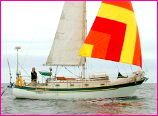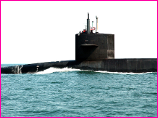Posted on July 19th, 2010 by ASEE
 Students learn about sailboat design and how the shape of sails affects their movement. They apply what they learn about sailboat design to their math lesson, which involves the basic postulate of right triangle trigonometry and the Pythagorean Theorem. The lesson provides a fun, hands-on way to demonstrate that the Pythagorean Theorem can be tested and proved.
Students learn about sailboat design and how the shape of sails affects their movement. They apply what they learn about sailboat design to their math lesson, which involves the basic postulate of right triangle trigonometry and the Pythagorean Theorem. The lesson provides a fun, hands-on way to demonstrate that the Pythagorean Theorem can be tested and proved.
Read More
Filed under: Grades 9-12, Lesson Plans | Comments Off on Lesson: The Math of Sailboat Design
Tags: Geometry, Grades 9-12, Lesson Plan, Mathematics, Nautical Engineering
Posted on July 19th, 2010 by ASEE
 Students in grades 5-8 learn the basic principle of buoyancy and how submarines use it to dive and ascend in water through creating their own submarine out of a soda bottle, pennies, and other household items. Activity courtesy of the National Museum of the U.S. Navy.
Students in grades 5-8 learn the basic principle of buoyancy and how submarines use it to dive and ascend in water through creating their own submarine out of a soda bottle, pennies, and other household items. Activity courtesy of the National Museum of the U.S. Navy.
Read More
Filed under: Class Activities, Grades 6-8, Grades 9-12, Grades K-5, K-12 Outreach Programs, Lesson Plans | 3 Comments »
Tags: buoyancy, Class Activities, Engineering Design Process, Nautical Engineering, Ocean, Ocean science, submarine, U.S. Navy
Posted on July 19th, 2010 by ASEE
 This lesson helps students understand how a submarine controls its buoyancy through the use of ballasts. Students construct a model ballast system, and then learn to control its vent valves to make it submerge and surface.
This lesson helps students understand how a submarine controls its buoyancy through the use of ballasts. Students construct a model ballast system, and then learn to control its vent valves to make it submerge and surface.
Read More
Filed under: Grades 6-8, Grades 9-12, Lesson Plans | 1 Comment »
Tags: Grade 7-12, Lesson Plan, Marine engineering, Nautical Engineering, Ocean, Underwater Robot
 Students learn about sailboat design and how the shape of sails affects their movement. They apply what they learn about sailboat design to their math lesson, which involves the basic postulate of right triangle trigonometry and the Pythagorean Theorem. The lesson provides a fun, hands-on way to demonstrate that the Pythagorean Theorem can be tested and proved.
Students learn about sailboat design and how the shape of sails affects their movement. They apply what they learn about sailboat design to their math lesson, which involves the basic postulate of right triangle trigonometry and the Pythagorean Theorem. The lesson provides a fun, hands-on way to demonstrate that the Pythagorean Theorem can be tested and proved. 








 Students in grades 5-8 learn the basic principle of buoyancy and how submarines use it to dive and ascend in water through creating their own submarine out of a soda bottle, pennies, and other household items. Activity courtesy of the National Museum of the U.S. Navy.
Students in grades 5-8 learn the basic principle of buoyancy and how submarines use it to dive and ascend in water through creating their own submarine out of a soda bottle, pennies, and other household items. Activity courtesy of the National Museum of the U.S. Navy. This lesson helps students understand how a submarine controls its buoyancy through the use of ballasts. Students construct a model ballast system, and then learn to control its vent valves to make it submerge and surface.
This lesson helps students understand how a submarine controls its buoyancy through the use of ballasts. Students construct a model ballast system, and then learn to control its vent valves to make it submerge and surface.